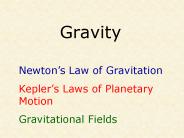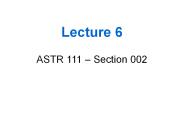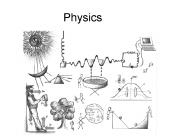Keplers 3rd Laws Planetary Motion Of Objects In The Solar System PowerPoint PPT Presentations
All Time
Recommended
chapter 26 26.2 observing the solar system: a history the movements of planets and stars geocentric model earth centered model used to explain planetary motion early ...
| PowerPoint PPT presentation | free to download
The Sun and the Solar System Chapter 26 24.3 Sun s Size, Heat and Structure Diameter= 1,400,000 km or 868,000 miles More than 3x the distance of Earth to moon More ...
| PowerPoint PPT presentation | free to view
Solar System, Kepler and Universal Gravitation Physics 12 Adv
| PowerPoint PPT presentation | free to view
The Solar System Observing the Solar System Ancient Observations The ancient Greeks observed the sky and noticed that the moon, sun, and stars seemed to move in a ...
| PowerPoint PPT presentation | free to view
Chapter 26.2: Observing the Solar System
| PowerPoint PPT presentation | free to view
Planetary Motions Newton s Laws: The New Physics Newton s Laws LAW 1: A body is in natural motion when it is at rest or when moving along at a constant speed ...
| PowerPoint PPT presentation | free to download
He discovered that the planets do not orbit in circles, but in ellipses. Kepler's Laws ... Mars has an atmosphere that is mainly carbon dioxide. ...
| PowerPoint PPT presentation | free to view
Astronomers such as Copernicus and Galileo were the 1st to suggest that the Sun ... At different times the shapes of the moon may be crescent, half, or gibbous (3/4) ...
| PowerPoint PPT presentation | free to view
Astronomy 101 The Solar System Tuesday, Thursday Tom Burbine tomburbine@astro.umass.edu
| PowerPoint PPT presentation | free to download
Historical Models of our Solar System Miss Scillieri 6th Grade
| PowerPoint PPT presentation | free to view
Chapter 2: The Copernican Revolution The Birth of Modern Science Ancient Astronomy Models of the Solar System Laws of Planetary Motion Newton s Laws
| PowerPoint PPT presentation | free to download
Astronomy 100 The Solar System Tuesday, Wednesday, Thursday Tom Burbine tomburbine@astro.umass.edu
| PowerPoint PPT presentation | free to download
Moon Rise/Set by Phase. The different phases also rise and set at ... Note: the moon spends as much time in the sky in ... on the phase of the Moon. ...
| PowerPoint PPT presentation | free to view
Chapter 2: The Copernican Revolution The Birth of Modern Science Ancient Astronomy Models of the Solar System Laws of Planetary Motion Newton s Laws
| PowerPoint PPT presentation | free to download
Planetary Motion by Nick D Anna Earth Science Teacher Plainedge Middle School Planet Names Tuesday Marted (Italian) Mars day Wednesday Mercoled (Italian ...
| PowerPoint PPT presentation | free to view
Neptune ... Neptune. Neptune's existence was predicted in advance. ... At times, it is closer to the sun than Neptune. Pluto has one satellite, named Charon. ...
| PowerPoint PPT presentation | free to view
Title: Linking Asteroids and Meteorites through Reflectance Spectroscopy Author: Smithsonian Institution Last modified by: Tom Created Date: 5/23/2001 8:09:58 PM
| PowerPoint PPT presentation | free to download
flown past or around every planet except Pluto ... Approximately half the size of Pluto, the icy world is called 'Quaoar' (pronounced kwa-whar) ...
| PowerPoint PPT presentation | free to view
Planets move around the Sun in elliptical orbits, with Sun as ... Similar in size and colour to Phoebe *(Sat Moon) Orbit 8.5 - 19 au. Fits definition of comet ...
| PowerPoint PPT presentation | free to view
1st Law: The orbits of the planets are ellipses, with the Sun at the one focus of ... Paddle In a kayak pull water back, kayak is propelled forward. Rocketry ...
| PowerPoint PPT presentation | free to view
The time for Mars to orbit the Sun is observed to be 1.88 Earth years. ... what you are speaking about and express it in numbers, you know something about ...
| PowerPoint PPT presentation | free to view
The Solar System is occupied by a diversity of objects, but shows an underlying ... The Solar System is also ordered in that the planets form two main families: ...
| PowerPoint PPT presentation | free to view
Early Models of the Solar System: The Movement of Planets & Stars Geocentric earth centered models Ptolemy (Greek) 150 AD developed his geocentric model that the ...
| PowerPoint PPT presentation | free to view
Gravity Newton s Law of Gravitation Kepler s Laws of Planetary Motion Gravitational Fields Newton s Law of Gravitation m1 m2 r There is a force of gravity ...
| PowerPoint PPT presentation | free to download
Agenda Week 7 Lecture: More on Motion Sidereal vs. Solar Motion and Models of the Solar System Lab: Keep up Moon journal and work on Moon paper
| PowerPoint PPT presentation | free to download
The Nature of Our Solar System
| PowerPoint PPT presentation | free to view
The Nature of Our Solar System ...
| PowerPoint PPT presentation | free to download
Chapter 2 Motions of Earth The material of Chapter 2 is covered in ASTR 1000, but there are a few concepts that are useful in ASTR 1001. 1. What we see in the sky ...
| PowerPoint PPT presentation | free to download
Solar System: Consists of the Sun, and everything bound to it by gravity. This includes the 8 planets and their moons, the asteroids, the dwarf planets, all the ...
| PowerPoint PPT presentation | free to download
Engage: Review a picture of the planets Explore: Analyze clues to the solar systems formation Explain: Develop a class model of solar system formation, compare ...
| PowerPoint PPT presentation | free to view
The Nature of Our Solar System Umbra Penumbra Penumbra Umbra Penumbra Penumbra Total Eclipse of the Sun Partial eclipse the view outside the penumbra Spectators ...
| PowerPoint PPT presentation | free to view
But how big is 1 Astronomical Unit (A.U.) in kilometres? Solar System Sizes. Glen Cowan ... a nice example of an astronomical event that led to student projects, ...
| PowerPoint PPT presentation | free to download
Title: Space Unit: The Solar System Author: Liberty Public Schools Last modified by: dabrams Created Date: 11/3/2003 4:11:09 PM Document presentation format
| PowerPoint PPT presentation | free to view
This is called retrograde motion ... went round it daily. The system proposed by Ptolemy. said that the Earth stays still and the Sun ...
| PowerPoint PPT presentation | free to view
Relative distances in the solar system (& somewhat beyond) ... Refracting telescopes. First telescopes used lenses. Lippershey (1608) Galileo (1609) ...
| PowerPoint PPT presentation | free to download
AP Physics 1 Chapter 7 Circular Motion and Gravitation ...
| PowerPoint PPT presentation | free to download
Lecture 6 ASTR 111 Section 002 Outline Exam Results Finish Chapter 4 Kepler s Laws Newton s Laws Exam Results - Average = 89% Percent error in student s ...
| PowerPoint PPT presentation | free to download
Kepler's 1st Law: A planet orbits the Sun in an ellipse, with the Sun at on ... Astronomical unit [AU], average distance between Earth and Sun: 1 AU = 1.496 108 ...
| PowerPoint PPT presentation | free to view
Chapter 4 Gravitation and the Waltz of the Planets The important concepts of Chapter 4 pertain to orbital motion of two (or more) bodies, central forces, and the ...
| PowerPoint PPT presentation | free to download
Recorded motions of Sun, Moon, and planets -- especially Venus. ... the morning and evening skies, but never at midnight (except in polar latitudes) ...
| PowerPoint PPT presentation | free to view
Recorded motions of Sun, Moon, and planets -- especially Venus. ... penny/cup/paper. 2nd: F=ma ... Could this force extend all the way to the Moon? ...
| PowerPoint PPT presentation | free to view
Astrology. Lasted 1500 years. Dead White Males. Nicolas Copernicus (1473-1543) ... What about free will? Natural laws in other domains. Economies (Adam Smith) ...
| PowerPoint PPT presentation | free to view
Earth-Moon-S/C: Star A, B, Planet. 1. Earth, Moon & Spacecraft - Stars A, B & Planet ... Nearest Binary Star System (e = 0.52) Two Stars Orbit about Barycenter ...
| PowerPoint PPT presentation | free to view
Generic Conical Orbits, Kepler s Laws, Satellite Orbits and Orbital Mechanics Guido Cervone Satellite Formation Demonstration Formalization In the following s ...
| PowerPoint PPT presentation | free to view
... constant; therefore the Sun has a daily motion greater at the perigee than at the apogee: ... Both bodies move with the same daily motion, which has the value: ...
| PowerPoint PPT presentation | free to view
Tycho, Kepler and Newton Great Astronomers
| PowerPoint PPT presentation | free to download
As the Moon travels in its almost circular ... effects in later Modules - for now, we will concentrate on the Earth Moon system. ...
| PowerPoint PPT presentation | free to download
The Copernican Revolution The Beginning of Modern Astronomy The 15th Century In 1453 Ottoman Turks overrun Constantinople. Romans flee west into Europe and take books ...
| PowerPoint PPT presentation | free to download
The History of Astronomy
| PowerPoint PPT presentation | free to download
Title: Volcanoes and Igneous Activity Earth - Chapter 4 Author: Stan & Cindy Hatfield Last modified by: Elizabeth Bartels Created Date: 12/18/2000 12:31:17 AM
| PowerPoint PPT presentation | free to view
Physics Henry Cavendish Experimented with electricity Tested the electric current by giving himself shocks and noting the pain he felt In 1747, Henry Cavendish ...
| PowerPoint PPT presentation | free to download
Title: Slide 1 Last modified by: Jeff Saul Document presentation format: Custom Other titles: Times New Roman Times StarSymbol StarBats Arial Symbol ...
| PowerPoint PPT presentation | free to view
Learning to Think About Gravity Concepts of Gravity from Aristotle to Newton Esther Zirbel Claudine Kavanagh Tufts University Overview of Class Tell students the ...
| PowerPoint PPT presentation | free to download
Learning to Think About Gravity Concepts of Gravity from Aristotle to Newton Esther Zirbel Claudine Kavanagh Tufts University Overview of Class Tell students the ...
| PowerPoint PPT presentation | free to download
Title: PowerPoint Presentation - Author: Media Center Last modified by: Administrator Created Date: 1/25/2002 9:59:40 AM Document presentation format
| PowerPoint PPT presentation | free to view
Ideas in Conflict: Geocentric vs. Heliocentric Model ... Part II: Historical Development of Astronomy Lambert E. Murray, Ph.D. Professor of Physics
| PowerPoint PPT presentation | free to view
























































